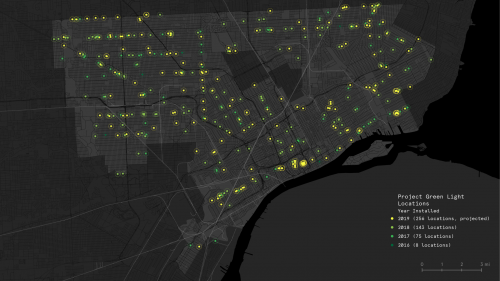Difference between revisions of "Project Green Light"
(e) |
|||
| Line 17: | Line 17: | ||
===Health and Well-Being=== | ===Health and Well-Being=== | ||
===Surveillance of Black Bodies=== | ===Surveillance of Black Bodies=== | ||
| + | Facial recognition is proven to be less effective for women and darker skinned individuals. Sociologist Ruha Benjamin has described contemporary biometric surveillance as a form of technologies used to support racist policies and practices through the tracking and control of Black people throughout American history. Surveillance of Black bodies has a long history can be traced back to slavery. The “lantern-laws” of 18th-century required Black people to illuminate themselves when passing white people in the street. The use of facial recognition on racial justice protestors recalls the COINTELPRO surveillance of Black activists and community organizers in the 1960s. Video surveillance in Detroit, a city with an 80% Black population has been theorized as a continuing legacy of oppression. Introducing the use of this technology through Project Green Light makes this massive facial recognition experiment the first of its kind in on a concentration of Black individuals. | ||
==See Also== | ==See Also== | ||
==References== | ==References== | ||
Revision as of 21:16, 27 January 2023
Project Green Light is a city-wide police surveillance system in Detroit, Michigan. The first public-private-community partnership of its kind,[1] Project Green Light Detroit utilizes real-time police monitoring using high-resolution cameras (1080p) whose images can be linked to the state of Michigan's facial recognition database, SNAP. The Project's aim is to deter and reduce city crime and is used in the pursuit of criminals.
Contents
History
Launched January 1, 2016 with support from Detroit Mayor Mike Duggan, eight city gas station businesses were recruited with the assurance from the Detroit Police Department that the flashing green lights and cameras to be installed at each location would help identify criminal suspects in any future crimes, as well as helping lower crime altogether.[2] With continued governmental and state support, Project Green Light expanded with the justification that Detroit Police Department data showed a decrease in “criminal activity” at the original eight locations. Since its inception, the number of institutions who pay for Project Green Light infrastructure has expanded to over 700 locations as of January, 2021.
In 2017, the city of Detroit contracted an agreement with DataWorks Plus and began to implement their facial recognition software, FacePlus into Project Green Light technologies.[3] FacePlus can automatically search any face that enters the camera's field of vision and may assess them against a statewide database.
According to news sources in June 2020,[4] Project Green Light has allegedly been used on crowds in Black Lives Matter protests using supplemental facial recognition technology to identify protestors who did not adhere to social distancing protocols, a violation which carries up to a $1,000 fine. Project Green Light images have also been allegedly used to help police identify and locate further #BLM protestors whose immigration status was under question.[5]
Methodology
As a public-private partnership, Project Green Light is a paid service that Detroit businesses, residential complexes, schools, restaurants, and other institutions opt into willingly. Each participant of Project Green Light pays for installation of cameras, signage, decals and green lights to identify that are part of the project
Concerns
Civil Liberties
Health and Well-Being
Surveillance of Black Bodies
Facial recognition is proven to be less effective for women and darker skinned individuals. Sociologist Ruha Benjamin has described contemporary biometric surveillance as a form of technologies used to support racist policies and practices through the tracking and control of Black people throughout American history. Surveillance of Black bodies has a long history can be traced back to slavery. The “lantern-laws” of 18th-century required Black people to illuminate themselves when passing white people in the street. The use of facial recognition on racial justice protestors recalls the COINTELPRO surveillance of Black activists and community organizers in the 1960s. Video surveillance in Detroit, a city with an 80% Black population has been theorized as a continuing legacy of oppression. Introducing the use of this technology through Project Green Light makes this massive facial recognition experiment the first of its kind in on a concentration of Black individuals.
See Also
References
- ↑ Project Green Light Detroit. City of Detroit. (n.d.). Retrieved January 25, 2023, from https://detroitmi.gov/departments/police-department/project-green-light-detroit
- ↑ Campbell, Eric T.; Howell, Shea; House, Gloria; & Petty, Tawana (eds.). (2019, August). Special Issue: Detroiters want to be seen, not watched. Riverwise. The Riverwise Collective.
- ↑ A critical summary of Detroit’s Project Green Light and its greater context. (n.d.). Retrieved January 26, 2023, from https://detroitcommunitytech.org/system/tdf/librarypdfs/DCTP_PGL_Report.pdf?file=1%26type=node%26id=77%26force=
- ↑ WXYZ-TV Detroit | Channel 7. (2020). Future of Facial Recognition Technology. Retrieved January 25, 2023, from https://www.youtube.com/watch?v=h-3_cTPqKI4.
- ↑ Race, policing, and Detroit's Project Green Light. UM ESC. (2020, June 25). Retrieved January 25, 2023, from https://esc.umich.edu/project-green-light/

